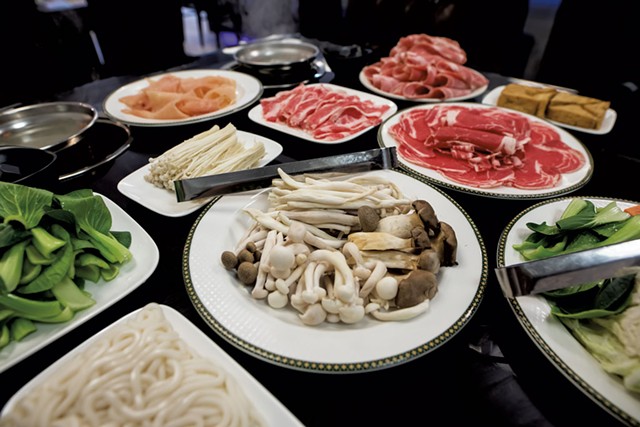
- Luke Awtry
- Assortment of hot pot ingredients
Sam Lai does a lot of explaining these days. During dinner service, the chef checks in on most tables at Café Dim Sum, the recently expanded Burlington restaurant he co-owns with his wife, Li Rong Lin. His aim is to help guests navigate the eatery's new evening offering.
As its name suggests, Café Dim Sum still serves a daytime menu of small plates, including dumplings, steamed sticky rice bundles and custard buns. But as of November 26, each Wednesday through Sunday at 4 p.m., it switches to serving a version of Chinese hot pot meets Japanese shabu-shabu.
To prepare the mostly do-it-yourself meal, diners cook thinly sliced meat, seafood, vegetables, noodles and other selections in individual pots of fragrant stock simmering on burners set into the tabletops. Each person also creates a customized dipping sauce from an array of ingredients at what Lai calls his "sauce bar."
It is a novel experience for many. "I'm trying to make it really complicated, so people come here five times to work it out," Lai, 45, said with characteristic dry humor.
The chef also still finds himself explaining the restaurant's daytime dim sum menu, from chicken feet to cheese-filled wontons. Since Café Dim Sum opened in October 2021, he has offered many classic dim sum items, along with a few that cater to local preferences (see "cheese-filled," above).
"Some traditional dishes are not suited to everybody. We're trying to do what works in Burlington," Lai said. "We don't want people to think this is dim sum dim sum," he continued, underscoring that he's not a purist. "Please don't compare us to big cities."
Word spread fast when Lai and Lin, 42, launched their tiny 20-seat restaurant at 95 St. Paul Street. It was the city's first dedicated dim sum destination, and the couple were soon overwhelmed by the demand for crystal shrimp dumplings, fried turnip cake and five-spice roast pork served with fluffy white buns.
"We just wanted a little space where people could have some tea and order a few small dishes," Lai said. "We expected calm."
Calm it was not. Café Dim Sum sold out most days and almost immediately ceased doing takeout. Customers frequently waited two hours for a table.
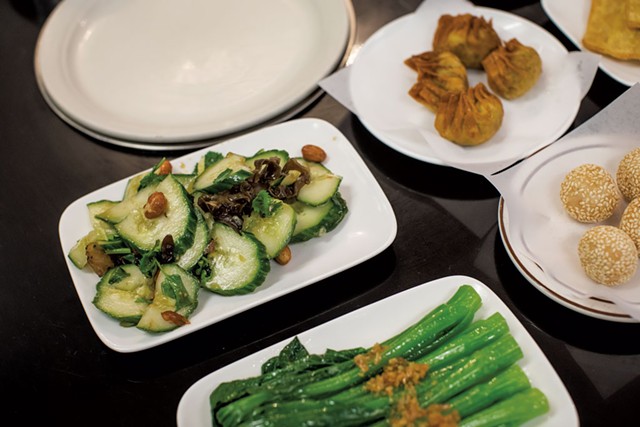
- Luke Awtry
- Dim sum selections (clockwise from left): cucumber salad, shrimp-and-chive dumplings, sesame balls, and yu choy
Lai and Lin began eyeing a soon-to-be-vacant suite next door in the same building. But the couple didn't want to expand dim sum hours, partly because dim sum is traditionally a daytime meal and partly because the dishes tend to be labor intensive.
"The biggest issue is this one bald guy cooking," Lai joked, referring to his own clean-shaven head. "I am still the only guy making it," he said as he sliced rehydrated dried shiitake mushrooms in the kitchen on a recent afternoon.
The couple decided to make hot pot for the same reason they'd chosen dim sum: an unfilled market niche. "We think it's suited [to] Vermont. It's cold here, and it's the most popular food in China in cold areas," Lai said.
After a little more than six months in business, Café Dim Sum closed temporarily on May 1 to expand into the neighboring space. It required extensive renovation, much done by Lai himself. Although the couple had hoped to reopen in July, supply chain issues caused delays. The final date of October 15 was auspicious, Lai said, matching their opening the previous year.
The new restaurant is large and airy, with 54 seats at tables and a stretch of bar bordering a central service area. Every seat has a built-in hot pot burner, covered by a plate during the day.
Café Dim Sum now offers beer, wine and hard cider. The expansion has changed the dim sum experience, too. After being seated at a table, customers now come to the counter to select their dishes from a large case holding dozens of plates and steamer pots, all priced well under $10. This system is more efficient than the previous one, in which many dishes were finished to order. The downside is that some items, such as the stiff triangles of fried scallion pancake ($7) that I sampled on a recent visit, may suffer when they don't turn over quickly.
The rotating list of about 30 dishes still includes many of this reporter's favorites, such as soft-bellied, seared slabs of turnip cake ($5.50); vinegary cucumber salad with wood ear mushrooms, peanuts and cilantro ($6.50); shrimp-and-pork bamboo roll, fried and then steamed, with a delightfully wrinkly tofu skin ($5.50); and velvety eggplant in black bean sauce ($4.50).
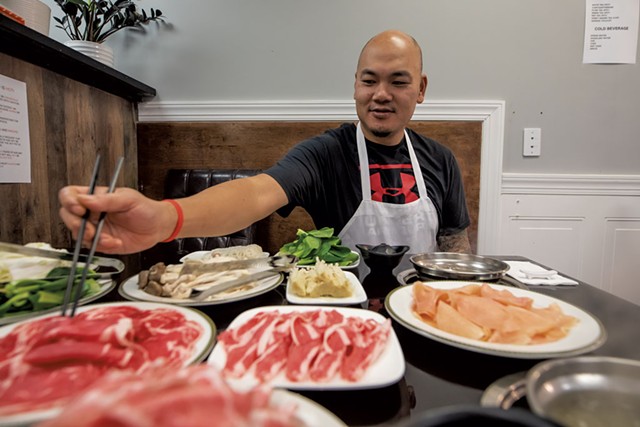
- Luke Awtry
- Sam Lai
Although Lai acknowledged that it's not traditional for a restaurant to serve both dim sum and hot pot, he paired the two by design. A pragmatist who grew up in his family's Chinese American restaurants in New Jersey and then Burlington before starting several of his own, Lai said the relatively simple prep for hot pot complements the labor-intensive dim sum.
For the evening menu, Lai prepares vegetables, slices meat, and makes the pork and vegetarian broths from scratch, seasoning them both delicately with goji berries, whole black cardamom pods and shiitake mushrooms. Many of the other hot pot ingredients, such as noodles and different kinds of seafood dumplings and fish balls, come premade.
There are other synergies between the two menus. The whole cuts of meat that Lai slices paper-thin for hot pot generate trim that he uses in dim sum. In the restaurant kitchen, the chef showed off a curried beef bao filling he had made from scraps of rib eye and fatty beef. "I waste nothing here," Lai said.
Rib eye and fatty beef (which Lai described as the cow equivalent of pork belly) are among the main course meat options ($28 to $38), which also include two cuts of pork and chicken breast. Diners can also choose a mixed seafood platter ($32), an assortment of fish balls ($30) or a vegetarian option ($28). All these generous portions come with a pot of broth, regularly topped off by servers with hot water as needed; a heaping plate of raw vegetables and mushrooms; a choice of noodles (udon or mung bean) or steamed rice; and unlimited sauce bar access.
Our table of three included Mieko Ozeki of Burlington, who grew up with hot pot and offered to help guide two newbies through the meal. After we ordered our mains — rib eye for Ozeki and pork shoulder and mixed seafood for the two Seven Days food writers — Ozeki cautioned us against putting too many items in our simmering broth at once. Crowding would cool it and make timely retrieval of various foods challenging.
Although Lai had assured us that hot pot "takes no skills," the first overcooked piece of food teaches diners to extract quick-cooking squid rings or slices of lean pork shoulder within seconds. I should have known from the name shabu-shabu, which is Japanese for "swish swish," a reference to the brief motion of each ingredient through the hot broth.
Using chopsticks to find food in the cloudy broth also requires some skill —though, thankfully, each diner also receives a pair of tongs. Throughout the meal, our ineptitude prompted plenty of laughter and only minimal loss.
"You create your own treasure hunt," my colleague Jordan Barry commented.
One aspect of hot pot that even Lai acknowledged takes some skill is concocting a good dipping sauce. I took his sage advice for rookies and started with a base of the restaurant's ginger-garlic dumpling sauce, to which I added a little peanut butter, some ground peanuts, more garlic, and a dash each of red and black vinegars. Back at the table, I poured in a little of the satay seafood sauce found on every table, along with a drizzle of Lai's signature chile oil.

- Luke Awtry
- Dim sum selections (clockwise from bottom left): eggplant in black bean sauce, shrimp and asparagus shumai, seafood sticky rice bundles, chicken shumai, custard buns, and sticky rice and red bean paste bundles
The sauce was delicious — and I will never be able to re-create it.
Our three mains made for a huge meal, with their included thick udon noodles and vegetables (my favorite was kabocha squash wedges). But, in the name of research, Ozeki also ordered a couple of items from the side dishes menu.
Soybean roll ($6) turned out to be rolls of fried tofu skin that unfurled in the hot broth into delectably light and crinkly lasagna-size noodles. Ozeki also ordered a plate of bite-size shrimp-and-pork wontons ($7), which cooked up beautifully in the stock. She later lamented that we should have tried the fried taro ($6), too.
Of the mains, the seafood mix won my vote for its varied textures and flavors, from raw shrimp to a baked fish cake that cooked up lightly rubbery in the best way. I'm not generally a fan of surimi, the "crab" stick featured in California rolls, but I loved how it fell apart into flossy seafood strands in the broth.
On my next visit, I will go with a friend (or two) and order one main to share, plus an extra pot of broth for $5 and several side dishes. One will definitely be the ginger-seasoned shrimp paste ($12), which Lai said a server would scrape into the soup to form tender balls.
When I asked Lai for one word to describe hot pot, he said simply, "It's fun" — a social, communal activity.
Based on the laughter around our steaming pots of broth, I would agree.
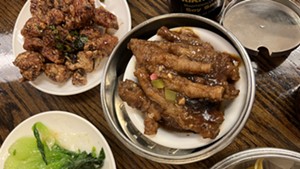

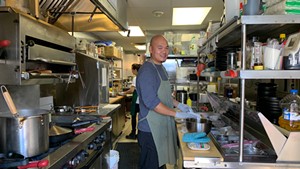










Comments
Comments are closed.
From 2014-2020, Seven Days allowed readers to comment on all stories posted on our website. While we've appreciated the suggestions and insights, right now Seven Days is prioritizing our core mission — producing high-quality, responsible local journalism — over moderating online debates between readers.
To criticize, correct or praise our reporting, please send us a letter to the editor or send us a tip. We’ll check it out and report the results.
Online comments may return when we have better tech tools for managing them. Thanks for reading.